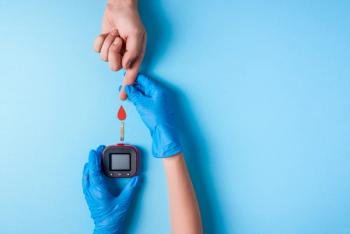
- Drug Topics May 2022
- Volume 166
- Issue 05
How to: A Guide for Launching HbA1c Point-of-Care Testing

This valuable service can make a meaningful difference.
If your pharmacy does not yet provide point-of-care testing services, the prospect of adding these offerings can seem daunting. This month, Drug Topics® spoke with 2 pharmacists offering hemoglobin A1c (HbA1c) testing, who break down the point-of-care process into attainable steps.
Prepare and Train
Before embarking on any point-of- care services journey, Nicole C. Pezzino, PharmD, BCACP, CDCES, associate professor of pharmacy practice, director of community outreach and innovation, and director of the postgraduate year 1 Community Pharmacy Residency Program at Wilkes University Nesbitt School of Pharmacy in Wilkes-Barre, Pennsylvania, and a pharmacist at Weis Markets, recommends that pharmacists look first at state law. A Clinical Laboratory Improvement Amendments of 1988 (CLIA) waiver1 is always necessary for point-of-care testing, but in Pennsylvania, where Pezzino practices, a lab license is also necessary.
Pezzino’s pharmacy already had an accredited diabetes self-management education and support (DSMES) program2 and a CDC-recognized diabetes prevention program. Because these programs already required routine blood glucose monitoring, adding HbA1c testing was a no-brainer, Pezzino explained. Weis Pharmacy began with an employee diabetes monitoring program called Live Well With Weis. After the success of the employee program became apparent, Pezzino began to expand HbA1c testing services to pharmacy patients.
Pezzino works under a protocol from a local physician and suggested that other pharmacists do the same by finding a physician with whom they have a good relationship. If this is an issue, “there are many protocol companies that you can employ to sign the protocol for you,” she said, adding that “physicians are generally very receptive to participating.” The protocol outlines when the test can be ordered, what to do with the results, and how frequently the pharmacist will communicate with the health care provider. And because all employees who perform tests must be trained, Pezzino and her staff have completed training from the National Association of Chain Drug Stores.3
Pezzino and her staff check both fasting blood glucose and HbA1c. “We address blood glucose in real time,” she said. “If the patient is hypoglycemic, we give glucose tablets.” Patients who are above range are referred to the DSMES program, and patients who are critical are referred for a same-day appointment with their health care provider.
Because diabetes is one of the top 5 most prevalent chronic diseases in
the United States4—and one of the top 10 most expensive for payers to treat5—Pezzino’s pharmacy offers HbA1c testing as a cash-pay service.“It is convenient for patients to come in and do a quick finger stick,” she said, adding that the pharmacy also offers free blood glucose screening. “The EmbracePro meter is less than $1 per test and helps...raise awareness and enroll patients in our programs.”
For HbA1c testing, Pezzino prefers PTS Diagnostics’ A1CNow+ test kit.“Be sure you purchase the professional kit, not the single-use kit, and make sure it’s a CLIA-waived kit,” she advised. These kits can be purchased from a medical supply company. She also suggested that pharmacists check with their state and county health departments, as well as their state pharmacy association, for available grant money for point-of-care testing.
In terms of marketing these services, Pezzino has seen the great-
est impact through word of mouth. But, she added, patients can also be reached through marketing channels like social media, partnerships with local gyms, and advertisements in local newspapers.
“HbA1c testing...is a nice tool to connect patients to other services and programs and [to] help people in the community because they don’t always have access to health care.”
Get Buy-in From Patients, Support Staff
Heather Ferrarese, PharmD, is the owner and pharmacist in charge at Bartle’s Pharmacy in Oxford, New York. Her pharmacy provides HbA1c testing through an initiative from the Community Pharmacy Enhanced Services Network (CPESN). Ferrarese and her team screen eligible patients by identifying those who are late on medication refills or who have weight issues. During patient consultations, Ferrarese emphasized the need to approach patients in a way that makes them feel good. For example, Ferrarese and her staff understand that in some rural areas, such as theirs, harsh weather and bad roads can make it difficult at times to get out and exercise or to go out and buy fresh produce. “We tell patients, ‘We can do better for you. We noticed you’re a little late taking your meds.’ We phrase it as ‘We can help you’—in a nonconfrontational way—and they are willing to open up,” Ferrarese explained.
Ferrarese utilizes CPESN to find a physician to sign the protocol and to source equipment. Her team reports back to that physician and explains the results to the patient. “We calculate HbA1c back to an average blood glucose number, which makes it easier to understand. We talk about results and how to improve them... Most people are very receptive because they know we are trying to help them,” she said.
Ferrarese suggested involving support staff as much as possible. These staff members can help with identifying patients, scheduling, and outreach. “[I]t’s OK to use support staff appropriately. They are more than capable and can really help speed the process along,” she said. “It also makes them feel included in the process and that they’re making a difference, so it’s a win-win for everyone.” Another win-win, Ferrarese said, is that HbA1c testing helps decrease the pharmacy’s direct and indirect renumeration fees. Any pharmacists who are interested in providing HbA1c testing as a point-of-care service should join their state CPESN network, Ferrarese said. “There are many tools and resources available. We work smarter and pool resources,” she explained.
Although pharmacists might face challenges along the way, providing HbA1c testing is worth it. “Diabetes is the seventh leading cause of death. No matter what setting, we all treat patients with diabetes, and doing this empowers them to take care of their health,” she said. “It is one of the best things you can do for them.”
Karen Berger, PharmD, is a graduate of the University of Pittsburgh School of Pharmacy. Her experience includes chain and independent pharmacy and medical writing and reviewing.
References
- Point-of-care testing (POCT). National Community Pharmacists Association. Accessed April 5, 2022.
https://ncpa.org/point-care-testing-poct - Diabetes self-management education and support (DSMES) toolkit. CDC. Updated August 10, 2021. Accessed April 5, 2022.
https://www.cdc.gov/diabetes/dsmes-toolkit/index.html - Community pharmacy-based point-of-care testing certificate program. National Association of Chain Drug Stores. Accessed April 5, 2022.
http://nacds.learnercommunity.com/Point-of-Care-Testing-Certificate - Raghupathi W, Raghupathi V. An empirical study of chronic diseases in the United States: a visual analytics approach to public health. Int J Environ Res Public Health. 2018;15(3):431. doi:10.3390/ijerph15030431
- Schmidt H. Top 10 most expensive chronic diseases for healthcare payers. Health Payer Intelligence. February 22, 2022. Accessed April 5, 2022.
https://healthpayerintelligence.com/news/top-10-most-expensive-chronic-diseases-for-healthcare-payers
Articles in this issue
over 3 years ago
The Future of Pharmacy is Digitalover 3 years ago
Pharmacy’s New "Dirty Little F-Word”over 3 years ago
Community Pharmacies Make Care Possible in Medical Desertsover 3 years ago
Abrocitinib for Atopic Dermatitisover 3 years ago
Women in Pharmacy Make Their Mark on the Professionover 3 years ago
New Highs in Cannabis Pharmacyover 3 years ago
Care at the Counter: Women's Health in the PharmacyNewsletter
Pharmacy practice is always changing. Stay ahead of the curve with the Drug Topics newsletter and get the latest drug information, industry trends, and patient care tips.

















































































































